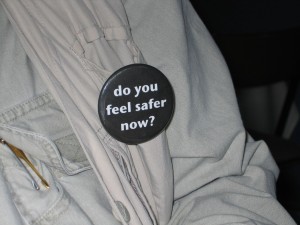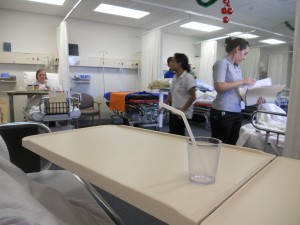
Declaration of interest: Papers and studies for which John Baker is a co-author have been included in the NICE draft evidence review that is the focus of this blog.
The Francis Inquiry (2013) focused the attention of the general public onto poor quality nursing care. As a direct result of this inquiry, NICE was asked to review the evidence base for safe nurse staffing levels in nine care settings in England. Two of these reviews focused on mental health, with reviews proposed for acute inpatient and community care. This work was halted in June 2015 by NHS England, and it was thought that the majority of this work would not be completed and published.
Inpatient (acute) mental health care has been under considerable strain, with increasing numbers of service users being detained under the Mental Health Act, suggestions of rising acuity (i.e. prioritising patient care based on the presenting symptoms/conditions during triage), all delivered in services with fewer beds.
There is a widely held perception that in recent years that cost continues to outweigh safety, with a reduction in, and the downgrading of qualified mental health nursing staff. Qualified nursing staff to patients ratios in acute inpatient wards are often less than the 1:8 recommended in other ward settings. There are numerous reports published over the last 20 years from service users about poor quality (Mind, 2013), unsafe and inadequate care (Mind, 2014) in acute inpatient wards.
To date, there has been limited guidance about the optimum nursing skill mix to ensure safe and effective acute inpatient care, and it did seem that the reviews conducted by NICE would never be made publicly available.
After 8 months of secrecy, I am pleased to see HSJ's website frontpage look like this today #safestaffing pic.twitter.com/UBuUfrQwgW
— Shaun Lintern (@ShaunLintern) January 20, 2016
Aims of the NICE safe staffing review
The review conducted by NICE had seven main questions:
- What service user and other outcomes are associated with safe staffing for nursing inpatient mental health settings?
- What service user factors affect nursing staff requirements in inpatient mental health settings?
- What environmental factors affect nursing staff requirements in inpatient mental health settings?
- What staffing factors affect nursing staff requirements in inpatient mental health settings?
- What organisational factors affect nursing staff requirements in inpatient mental health settings?
- What core nursing activities should be considered when determining safe staffing requirements for nursing in inpatient mental health settings?
- What approaches for identifying safe staffing for nursing and/or skill mix, including toolkits, are effective in inpatient mental health settings and how frequently should they be used?

Evidence about safe staffing levels should be not be suppressed.
Methods
A broad search of the literature was undertaken using the standard methodology for NICE guidelines. A range of databases were searched including BNI, CENTRAL, CINAHL, DARE, EMBASE, Cochrane, and Medline. Literature published from 1998 onwards was included.
The review included all inpatient mental health settings, across a range of countries. Although papers needed to focus on staffing and outcomes and/or other factors, patient satisfaction was excluded unless it related to staffing.
The review focused on 4 main outcomes:
- Serious incidents, and coercive interventions (conflict and containment outcomes)
- The delivery of nursing care
- ‘Others’: including access to services and assessment
- Reported feedback from service users and carers
Results
- 29 papers were included, the majority of which were observational studies:
- 25 studies were classed as cross-sectional,
- 10 studies (rated of low quality) described associations.
- Literature was included from a range of clinical settings and a number of countries including England, Scotland, Norway, Australia, USA, New Zealand, Japan and Switzerland.
- The majority of the papers came from studies associated with Professor Len Bowers and the CITY 128 project (Bowers et al, 2006).
- There was widespread variation in reporting staffing levels and measuring outcomes.
- Four studies linked staffing levels and conflict; concluding that higher staffing levels were associated with increased rates of assault.
- Three studies linked staffing and containment interventions, which again indicated that higher staffing levels were linked with more seclusion and restraint.
- Five studies explored staffing and ward outcomes, and it appeared that fewer staff were linked with greater emotional exhaustion.
- 16 papers linked staffing and containment and conflict outcomes, the majority of which were conducted by Bowers. Results suggested that male and more qualified staff were present prior to conflicts occurring, and higher levels of unqualified and temporary staff were associated with high levels of conflict and containment.
- Only two studies provided data on what nurses do.
- No studies provided sufficient detail to identify safe staffing levels.

Higher staffing levels were associated with increased assaults, more seclusion and restraint.
Conclusions
The guidelines concluded that there was:
- No evidence that specifically describes how minimum staffing levels or ratios may support safer nursing in inpatient mental health settings.
- A lack of high quality intervention studies demonstrating the direction of the relationship between nurse staffing and key outcomes.
- No evidence on service user factors which may need to be taken into account when setting nurse staffing establishments.
- Very little evidence on environmental and organisational factors which may need to be taken into account when setting nurse staffing establishments.
- No robust evidence to support the use of particular approaches or toolkits for identifying safe staffing requirements for nursing and/or skill mix.
- No evidence from economic evaluations regarding the cost effectiveness of different nurse staffing models or approaches.

What needs to change for acute inpatient wards to offer safe environments and therapeutic interventions?
Discussion
The findings of NICE are not surprising; there is a dearth of research into acute inpatient wards, how they should be staffed, and more importantly the key outcomes that they should be producing.
The majority of literature included in these guidelines focused on coercive interventions, but it seems clear that the presence of qualified nursing staff contribute to reduced frequency of the need for these interventions. However, these are probably not the outcomes that service users would prioritise and it remains clear that acute inpatient wards do not offer safe environments and therapeutic interventions that meaningfully contributed towards an individual’s recovery.
It is clear that when wards are disturbed, additional nursing and support staff are deployed to bolster the numbers. These staff are often unqualified nursing assistants provided through bank or agency systems. This is often costly and these additional staff are more likely to use coercive means to manage the ward environment. They are also less likely to know the service users on the ward. Additional investment in qualified nursing staff may enable staffing levels to move from the current minimum unsafe level to levels which enable therapeutic environments to occur. This could result in better quality and safer care, improved outcomes, and reduce costs associated with the use of bank and agency staff.
Whilst governments are always reluctant to mandate numbers of staff because of the economic and political consequences, it is important that evidence which can encourage informed debates is not suppressed. There is also a debate to be had within the profession and wider service about the mix of staff required to provide the optimum care within acute inpatient wards. However, the work delivered in place of the Mental Health Staffing Framework is not supported by this review as an evidence-based method. There is no indication that the Mental Health Taskforce has included #SafeStaffing within their remit, and the working groups which were to be delivered to conduct additional work have not yet been convened.
Indeed the nursing profession has been slow to develop research of sufficient quality to ensure #SafeStaffing in mental health settings. This has resulted in acute inpatient wards with fewer nurses, and those who remain are often on lower grades, resulting in an unsafe and ineffective minimum number of staff.
The unearthing of this review should galvanise the mental health nursing community to answer this vital question: how many nurses does it take to provide a safe and therapeutic environment on an acute mental health inpatient ward?

How many nurses does it take to provide a safe and therapeutic environment on an acute mental health inpatient ward?
Public acknowledgement
This NICE draft evidence review would not have been made publicly available if not for the work of Shaun Lintern, Patient Safety Correspondent at the Health Services Journal.
Links
Primary paper
NICE (2016) Safe Staffing for Nursing in Inpatient Mental Health Settings (PDF). National Institute for Health and Care Excellence, Draft evidence review, 2016.
Other references
Royal College of Nursing. (2014) Frontline First: Turning back the clock? RCN report on mental health services in the UK. November 2014.
Francis R. (2013) Report of the Mid Staffordshire NHS Foundation Trust Public Inquiry: executive summary. Jan 2013.
Bowers L. et al (2006) The City 128 Study of Observation and Outcomes on Acute Psychiatric Wards: report to the NHS SDO Programme (PDF). City University Department of Mental Health and Learning Disability, Dec 2006.
MIND (2013) Huge rise in complaints about mental health care made to NHS, MIND, London.
MIND (2014) Parliamentary briefing from Mind (PDF), MIND, London.
NHS England (2015) Mental Health Staffing Framework. NHS England, London.
Further information about Len Bowers and the City128 study is available on Twitter at #SafeStaffing and also in this YouTube presentation from Professor Bowers.

RT https://t.co/bxqf03Nh7Y #SafeStaffing Mental health nursing on inpatient wards https://t.co/HrKkowWMVh Mental_Elf
#SafeStaffing Mental health nursing on inpatient wards https://t.co/OTGI8bKiVg #MentalHealth https://t.co/18Ar7HmBzG
RT iVivekMisra #SafeStaffing Mental health nursing on inpatient wards https://t.co/LuBBQpUKkn #MentalHealth https://t.co/BodNuFRKNU
#SafeStaffing Mental health nursing on inpatient wards https://t.co/B1hmMk2IoW via sharethis
My blog for @mentalelf #safestaffing in acute mental wards https://t.co/58RugjicdE from the NICE guidelines freed by @ShaunLintern
Today @JohnBaker_Leeds on @NICEcomms leaked review of #SafeStaffing for nursing in inpatient #MentalHealth settings https://t.co/VN6VSTaNIA
@Mental_Elf @JohnBaker_Leeds Good article John and very timely! Issue for me- No’s & Presence of staff/availability to SUs not to do admin!!
RT Mental_Elf Today JohnBaker_Leeds on NICEcomms leaked review of #SafeStaffing for nursing in inpatient #MentalHe… https://t.co/AmClBjAqYz
After several years organising weekly visits to acute wards I suggest this review is looking under the wrong stones. Should be looking at whether the staff actually engage with the patients, patient satisfaction, whether staff spend most of the shift sitting in the office, and whether staff are permanent or agency. Trouble comes when basic humanity that has been managed out of these environments.
#SafeStaffing Mental health nursing on inpatient wards https://t.co/z23dc4WyxG
Props to @ShaunLintern for unearthing @NICEcomms #SafeStaffing guidance. Our blog on #MentalHealth implications: https://t.co/VN6VSTaNIA
.@Mental_Elf @NICEcomms Really pleased to see discussion of this in the public domain. As it should always have been. #safestaffing
RT Mental_Elf Props to ShaunLintern for unearthing NICEcomms #SafeStaffing guidance. Our blog on #MentalHealth imp… https://t.co/AmClBjS2n9
.@Mental_Elf fab on safe staffing: v little evidence, indication that temporary staff uplifts may increase coercion
https://t.co/XdgdNym7vF
Thanks very much for this succinct and useful summary of the NICE evidence review on safe staffing in acute mental health inpatient units John.
First to acknowledge my interest in this. I worked with Len Bowers on both the City-128 and Tompkins longitudinal acute wards (TAWS) studies cited in this review.
As you say, the results of this review demonstrate that there has been a lack of investment and support for high quality research in acute mental health services, but also arguably a lack of interest and commitment amongst mental health nurse researchers to explore a complex area that is core to our profession.
That complexity is perhaps part of the problem. A detailed reading of Bowers et al’s hugely successful and now widely SafeWards intervention study shows just how challenging – and expensive – it is to conduct a rigorous, high-quality study in a demanding, ever-moving environment.
But we also perhaps need to move away from uni-disciplinary investigation of inpatient care and work with our disciplinary colleagues to mount a comprehensive, detailed investigation of how we best provide safe, effective, recovery-focused care, treatment and support for people in acute crisis.
At the heart of such research of course, should be collaboration with and involvement of service users and carers to ensure their perspectives are central to that endeavour – as was the case in the SafeWards* study.
Alan
* Safewards study:
http://www.journalofnursingstudies.com/article/S0020-7489(15)00160-1/abstract
Great comment from @cityalan on @JohnBaker_Leeds #SafeStaffing blog https://t.co/aQHT6dXyZO Join the discussion now!
@Mental_Elf @JohnBaker_Leeds How come you see the typos after postin?
RT https://t.co/PiJNjmGpfL Great comment from cityalan on JohnBaker_Leeds #SafeStaffing blog https://t.co/wdzTg5cig0 Join the discussion …
Angela Payne
Succinct, useful summary @JohnBaker_Leeds of NICE review #SafeStaffing Mental health nursing on inpatient wards https://t.co/YY9vnbagye
#SafeStaffing Mental health nursing on inpatient wards https://t.co/5sK3WEvLIf via sharethis #skill mix @OntarioShores
Great blog John and nicely to the point. We need evidence and we need real intention to fund studies to develop this evidence. I take Alan’s point that perhaps mental health nurse researchers have shied away from this area of research, it’s very complex. I wonder too if we are also seeing a more general value judgment about researching mental health settings that views this as less of a priority within health research.
I was thinking this morning if a member of my family needed mental health inpatient care what would I want for them and sufficient amounts of suitably enabled, educated, compassionate and properly qualified mental health nurses would I think give them the best chance of recovery. To demonstrate this though we would need research that would fund and then test this against outcomes that people using services say are meaningful to them. Len and Alan’s work and your own John is a start but it remains telling that these are exceptions rather than part of a wider evidence base for a form of care that has been around for more than 150 years.
#SafeStaffing Mental health nursing on inpatient wards https://t.co/bn8WevXisd via @sharethis
#SafeStaffing Mental health nursing on inpatient wards https://t.co/rUk9i8zZ9m via @sharethis
#SafeStaffing mental health #nursing on inpatient wards https://t.co/jHtLYJwIlH @Mental_Elf finds a paucity of #evidence in the NICE review
How many nurses does it take to provide a safe environment on an acute mental health inpatient ward? https://t.co/VN6VSTaNIA #SafeStaffing
Great! #SafeStaffing’s getting Twitter traction https://t.co/hJ9j2UuHEO Our blog on how it affects #MentalHealth https://t.co/VN6VSTaNIA
RT Mental_Elf Great! #SafeStaffing’s getting Twitter traction https://t.co/kyF4kgtZx9 Our blog on how it affects … https://t.co/AmClBjS2n9
excellent blog @JohnBaker_Leeds https://t.co/s02ukl7NdF will be taking to newly revitalised safer staffing group. #skillmix is a biggy 4 me
What needs to change for acute inpatient wards to offer safe environments & therapeutic interventions? https://t.co/VN6VSTaNIA #SafeStaffing
@Mental_Elf @JohnBaker_Leeds Bowers work- 2006 feels a long time ago. How easy for staff to project a calm manner on an acute ward in 2016?
RT @Mental_Elf: Evidence about #SafeStaffing levels should be not be suppressed, says @JohnBaker_Leeds https://t.co/VN6VSTaNIA Kudos to @Sh…
From @Mental_Elf https://t.co/XNdS6pnBHJ
Excellent post, John: thank you, and to Shaun Lintern from the HSJ for liberating the NICE review.
#safestaffing is as complex as it is important. Here’s a link to a lecture delivered by Linda Aiken, in which she talks about ‘Quality nursing care: what makes a difference?’:
http://estream.southwales.ac.uk/Embed.aspx?id=11217&extended=true&wmode=opaque&pID=98&code=bP~y0vebjsSfWnEDezsDBEByrJioE
Prof Aiken references the RN4CAST study, which investigates the relationships between the characteristics of the nursing workforce and outcomes for surgical patients. It’s not about mental health nursing, but it is another example of research in this broad area.
Linda Aiken’s recorded talk was delivered here in Wales, where progress is being made on a safe staffing bill:
https://www.rcn.org.uk/news-and-events/news/health-and-social-care-committee-backs-safe-nurse-staffing-levels-bill
RT @Mental_Elf: Don’t miss: #SafeStaffing Mental health nursing on inpatient wards https://t.co/VN6VSTaNIA
#SafeStaffing Mental health nursing on inpatient wards https://t.co/V4qHJgKUmM via @sharethis
Most popular blog this week? It’s @JohnBaker_Leeds #SafeStaffing Mental health nursing on inpatient wards https://t.co/VN6VSTaNIA
.@Mental_Elf thanks, wouldn’t have been possible without @ShaunLintern
#SafeStaffing Mental health nursing on inpatient wards https://t.co/EuBahaK6gK
RT @Mental_Elf How many nurses does it take to provide a safe environment on an acute mental health inpatient ward? https://t.co/zr7pRmi4XL
Las unidades de agudos en Salud Mental no ofrecen entornos seguros ni terapias que contribuyan a la recuperación https://t.co/SvyFcEzjEw
RT https://t.co/PhJpC8oRKK “#SafeStaffing Mental health nursing on inpatient wards” https://t.co/7wHx0lXAUd felly500
RT @Saratmz: Qué debe cambiar en las plantas de psiquiatría para convertirlas en entornos seguros y terapéuticos? Vía @cgblanch1 https://t.…
RT @Mental_Elf: Useful comment & links from @benhannigan on @JohnBaker_Leeds #MentalHealth #SafeStaffing blog https://t.co/E9ggUseSdm
RT @Mental_Elf: Thanks to @D10Coff for the great comment on @JohnBaker_Leeds #SafeStaffing #MentalHealth blog https://t.co/JNb3L6Bi1U
RT @JohnBaker_Leeds: #SafeStaffing inpatient MH wards, not much from senior nurses/policy makers not just a academic debate https://t.co/eA…
RT @anne_feltonmh: #SafeStaffing Shining the light on staffing levels in mental health care @WeMHNurses @Mental_Elf @JohnBaker_Leeds
https…
@lucianaberger @guardian https://t.co/58RugjicdE more on #safestaffing and mental health
Hi @JohnBaker_Leeds
A well deserved #ClarityBadger
For your fab #SafeStaffing blog
https://t.co/VN6VSTaNIA https://t.co/pXc080R4D5
@Mental_Elf many thanks got a cete now!
RT @KristinBaird: #SafeStaffing Mental health nursing on inpatient wards https://t.co/ifAQCt96OS
IMPORTANT LINK for #SafeStaffing Mental health nursing on inpatient wards https://t.co/042L164eTP
https://t.co/042L164eTP #wemhns ‘#safestaffing
RT @Mental_Elf: @JohnBaker_Leeds #SafeStaffing blog
Mental health nursing on inpatient wards
https://t.co/dyJpfIHG9g
#wemhns https://t.co/J…
#SafeStaffing Mental health nursing on inpatient wards https://t.co/CtSngyJpPr via @sharethis